Characterization and Quantification of Dam Seepage Based on Resistivity and Geological Information
Abstract
1. Introduction
2. Materials and Methods
2.1. Site Description
2.2. Electrical Resistivity Tomography
2.3. Numerical Modeling of Seepage
3. Results
3.1. ERT Survey Results
3.2. Seepage Simulation Results
4. Discussion
4.1. Localization of Seepage
4.2. Quantification of Seepage
5. Conclusions
Author Contributions
Funding
Data Availability Statement
Conflicts of Interest
References
- Shen, Y.; Chen, Y. Global perspective on hydrology, water balance, and water resources management in arid basins. Hydrol. Process. 2010, 24, 129–135. [Google Scholar] [CrossRef]
- Wen, F.; Guan, W.H.; Yang, M.X.; Cao, J.X.; Zou, Y.B.; Liu, X.; Wang, H.J.; Dong, N.P. The Optimization of Water Storage Timing in Upper Yangtze Reservoirs Affected by Water Transfer Projects. Water 2023, 15, 3393. [Google Scholar] [CrossRef]
- Men, B.H.; Liu, H.L.; Tian, W.; Wu, Z.J.; Hui, J. The Impact of Reservoirs on Runoff Under Climate Change: A Case of Nierji Reservoir in China. Water 2019, 11, 1005. [Google Scholar] [CrossRef]
- Miao, C.Y.; Borthwick, A.G.L.; Liu, H.H.; Liu, J.G. China’s Policy on Dams at the Crossroads: Removal or Further Construction? Water 2015, 7, 2349–2357. [Google Scholar] [CrossRef]
- Cho, I.K.; Yeom, J.Y. Crossline resistivity tomography for the delineation of anomalous seepage pathways in an embankment dam. Geophysics 2007, 72, 31–38. [Google Scholar] [CrossRef]
- Hung, Y.C.; Chen, T.T.; Tsai, T.F.; Chen, H.X. A Comprehensive Investigation on Abnormal Impoundment of Reservoirs—A Case Study of Qionglin Reservoir in Kinmen Island. Water 2021, 13, 1463. [Google Scholar] [CrossRef]
- Foster, M.; Fell, R.; Spannagle, M. The statistics of embankment dam failures and accidents. Can. Geotech. J. 2000, 37, 1000–1024. [Google Scholar] [CrossRef]
- Richards, K.S.; Reddy, K.R. Experimental investigation of initiation of backward erosion piping in soils. Geotechnique 2012, 62, 933–942. [Google Scholar] [CrossRef]
- Jiang, T.; Zhang, J.R.; Wan, W.F.; Cui, S.; Deng, D.P. 3D transient numerical flow simulation of groundwater bypass seepage at the dam site of Dongzhuang hydro-junction. Eng. Geol. 2017, 231, 176–189. [Google Scholar] [CrossRef]
- Rozycki, A.; Fonticiella, J.M.R.; Cuadra, A. Detection and evaluation of horizontal fractures in earth dams using the self-potential method. Eng. Geol. 2006, 82, 145–153. [Google Scholar] [CrossRef]
- Song, S.H.; Song, Y.; Kwon, B.D. Application of hydrogeological and geophysical methods to delineate leakage pathways in an earth fill dam. Explor. Geophys. 2005, 36, 92–96. [Google Scholar] [CrossRef]
- Lin, C.P.; Hung, Y.C.; Wu, P.L.; Yu, Z.H. Performance of 2-D ERT in investigation of abnormal seepage: A case study at the Hsin-Shan earth dam in Taiwan. J. Environ. Eng. Geophys. 2014, 19, 101–112. [Google Scholar] [CrossRef]
- Xia, T.; Meng, J.; Ding, B.T.; Chen, Z.F.; Liu, S.L.; Titov, K.; Mao, D.Q. Integration of hydrochemical and induced polarization analysis for leachate localization in a municipal landfill. Waste Manag. 2023, 157, 130–140. [Google Scholar] [CrossRef]
- Hu, Z.H.; Wang, Y.X.; Ye, M.S.; Liu, M.; Ding, J.Q. Localization of potential leakage areas inside plain reservoirs using waterborne electrical resistivity tomography. J. Environ. Eng. Geophys. 2021, 26, 133–143. [Google Scholar] [CrossRef]
- Yun, T.; Karl, E.B.; MacQuarrie, K.T.B. Investigation of seepage near the interface between an embankment dam and a concrete structure: Monitoring and modelling of seasonal temperature trends. Can. Geotech. J. 2023, 60, 453–470. [Google Scholar] [CrossRef]
- Khan, A.A.; Vrabie, V.; Beck, Y.L.; Mars, I.J.; DUrso, G. Monitoring and early detection of internal erosion: Distributed sensing and processing. Struct. Health Monit. 2014, 13, 562–576. [Google Scholar] [CrossRef]
- McMahon, P.B.; Carney, C.P.; Poeter, E.P.; Peterson, S.M. Use of geochemical, isotopic, and age tracer data to develop models of groundwater flow for the purpose of water management, northern High Plains aquifer. Appl. Geophys. 2010, 25, 910–922. [Google Scholar] [CrossRef]
- Ling, C.; Revil, A.; Abdulsamad, F.; Qi, Y.; Ahmed, A.S.; Shi, P.; Nicaise, S.; Peyras, L. Leakage detection of water reservoirs using a Mise-à-la-Masse approach. J. Hydrol. 2019, 572, 51–65. [Google Scholar] [CrossRef]
- Ikard, S.J.; Rittgers, J.; Revil, A.; Mooney, M.A. Geophysical Investigation of Seepage Beneath an Earthen Dam. Groundwater 2015, 53, 238–250. [Google Scholar] [CrossRef]
- Hu, Z.H.; Liu, M.; Wang, Y.X.; Ye, M.S.; Li, S.X. Geophysical Assessment of Freshwater Intrusion into Saline Aquifers Beneath Plain Reservoirs. J. Environ. Eng. Geophys. 2022, 27, 13–22. [Google Scholar] [CrossRef]
- Di Prinzio, M.; Bittelli, M.; Castellarin, A.; Rossi Pisa, P. Application of GPR to the monitoring of river embankments. J. Appl. Geophys. 2010, 71, 53–61. [Google Scholar] [CrossRef]
- Daily, W.; Ramirez, A.; Binley, A. Remote Monitoring of Leaks in Storage Tanks using electrical resistance tomography: Application at the Hanford site. J. Environ. Eng. Geophys. 2004, 9, 11–24. [Google Scholar] [CrossRef]
- Golebiowski, T.; Piwakowski, B.; Cwiklik, M.; Bojarski, A. Application of Combined Geophysical Methods for the Examination of a Water Dam Subsoil. Water 2021, 13, 2981. [Google Scholar] [CrossRef]
- Antoine, R.; Fauchard, C.; Fargier, Y.; Durand, E. Detection of leakage areas in an earth embankment from GPR measurements and permeability logging. Int. J. Geophys. 2015, 2015, 610172. [Google Scholar] [CrossRef]
- Bolève, A.; Revil, A.; Janod, F.; Mattiuzzo, J.L.; Fry, J.-J. Preferential fluid flow pathways in embankment dams imaged by self-potential tomography. Near Surf. Geophys. 2009, 7, 447–462. [Google Scholar] [CrossRef]
- Revil, A.; Cary, L.; Fan, Q.; Finizola, A.; Trolard, F. Self-potential signals associated with preferential ground water flow pathways in a buried paleo-channel. Geophys. Res. Lett. 2005, 32, L07401. [Google Scholar] [CrossRef]
- Ahmed, A.S.; Revil, A.; Steck, B.; Vergniault, C.; Jardani, A.; Vinceslas, G. Self-potential signals associated with localized leaks in embankment dams and dikes. Eng. Geol. 2019, 253, 229–239. [Google Scholar] [CrossRef]
- Ikard, S.J.; Carroll, K.C.; Rucker, D.F.; Adams, R.F.; Brooks, S.C. Geoelectric characterization of hyporheic exchange flow in the bedrock-lined streambed of East Fork Poplar Creek, Oak Ridge, Tennessee. Geophys. Res. Lett. 2023, 50, e2022GL102616. [Google Scholar] [CrossRef]
- Cardarelli, E.; Cercato, M.; De Donno, G. Characterization of an earth-filled dam through the combined use of electrical resistivity tomography, P- and SH-wave seismic tomography and surface wave data. J. Appl. Geophys. 2014, 106, 87–95. [Google Scholar] [CrossRef]
- Fargier, Y.; Lopes, P.S.; Fauchard, C.; François, D.; Côte, P. DC-electrical resistivity imaging for embankment dike investigation: A 3D extended normalization approach. J. Appl. Geophys. 2014, 103, 245–256. [Google Scholar] [CrossRef]
- Perri, M.T.; Boaga, J.; Bersan, S.; Cassiani, G.; Cola, S.; Deiana, R.; Simonini, P.; Patti, S. River embankment characterization: The joint use of geophysical and geotechnical techniques. J. Appl. Geophys. 2014, 11, 5–22. [Google Scholar] [CrossRef]
- Loperte, A.; Soldovieri, F.; Lapenna, V. Monte Cotugno dam monitoring by the electrical resistivity tomography. IEEE J. Sel. Top. Appl. Earth Obs. Remote Sens. 2015, 8, 5346–5351. [Google Scholar] [CrossRef]
- Rahimi, S.; Moody, T.; Wood, C.; Kouchaki, B.M.; Barry, M.; Tran, K.; King, C. Mapping subsurface conditions and detecting seepage channels for an embankment dam using geophysical methods: A case study of the Kinion Lake dam. J. Environ. Eng. Geophys. 2019, 24, 373–386. [Google Scholar] [CrossRef]
- Hojat, A.; Ferrario, M.; Arosio, D.; Brunero, M.; Ivanov, V.I.; Longoni, L.; Madaschi, A.; Papini, M.; Tresoldi, G.; Zanzi, L. Laboratory studies using electrical resistivity tomography and fiber optic techniques to detect seepage zones in river embankments. Geosciences 2021, 11, 69. [Google Scholar] [CrossRef]
- Sjödahl, P.; Dahlin, T.; Johansson, S. Embankment dam seepage evaluation from resistivity monitoring data. Near Surf. Geophys. 2009, 7, 463–474. [Google Scholar]
- Mao, D.Q.; Wang, Y.X.; Guo, Q.F.; Li, D.J.; Liu, S.L.; Meng, J.; Hu, L.J. Heterogeneous reservoir seepage characterized by geophysical, hydrochemical and hydrological methods. Geophysics 2024, 89, 1–47. [Google Scholar] [CrossRef]
- Tso, C.M.; Kuras, O.; Wilkinson, P.B.; Uhlemann, S.; Chambers, J.E.; Meldrum, P.I.; Graham, J.; Sherlock, E.F.; Binley, A. Improved Characterisation and Modelling of Measurement Errors in Electrical Resistivity Tomography (ERT) Surveys. J. Appl. Geophys. 2017, 146, 16–26. [Google Scholar] [CrossRef]
- Loke, M.H.; Barker, R.D. Rapid least squares inversion of apparent resistivity pseudosections by a quasi-Newton method. Geophys. Prospect. 1996, 44, 131–152. [Google Scholar] [CrossRef]
- Loke, M.H. Tutorial: 2-D and 3-D Electrical Imaging Surveys: Geotomosoft Solutions, Malaysia. Available online: www.geotomosoft.com (accessed on 1 July 2024).
- Heat and Mass Transfer Modeling with GeoStudio. Available online: https://www.geoslope.com/ (accessed on 1 July 2024).
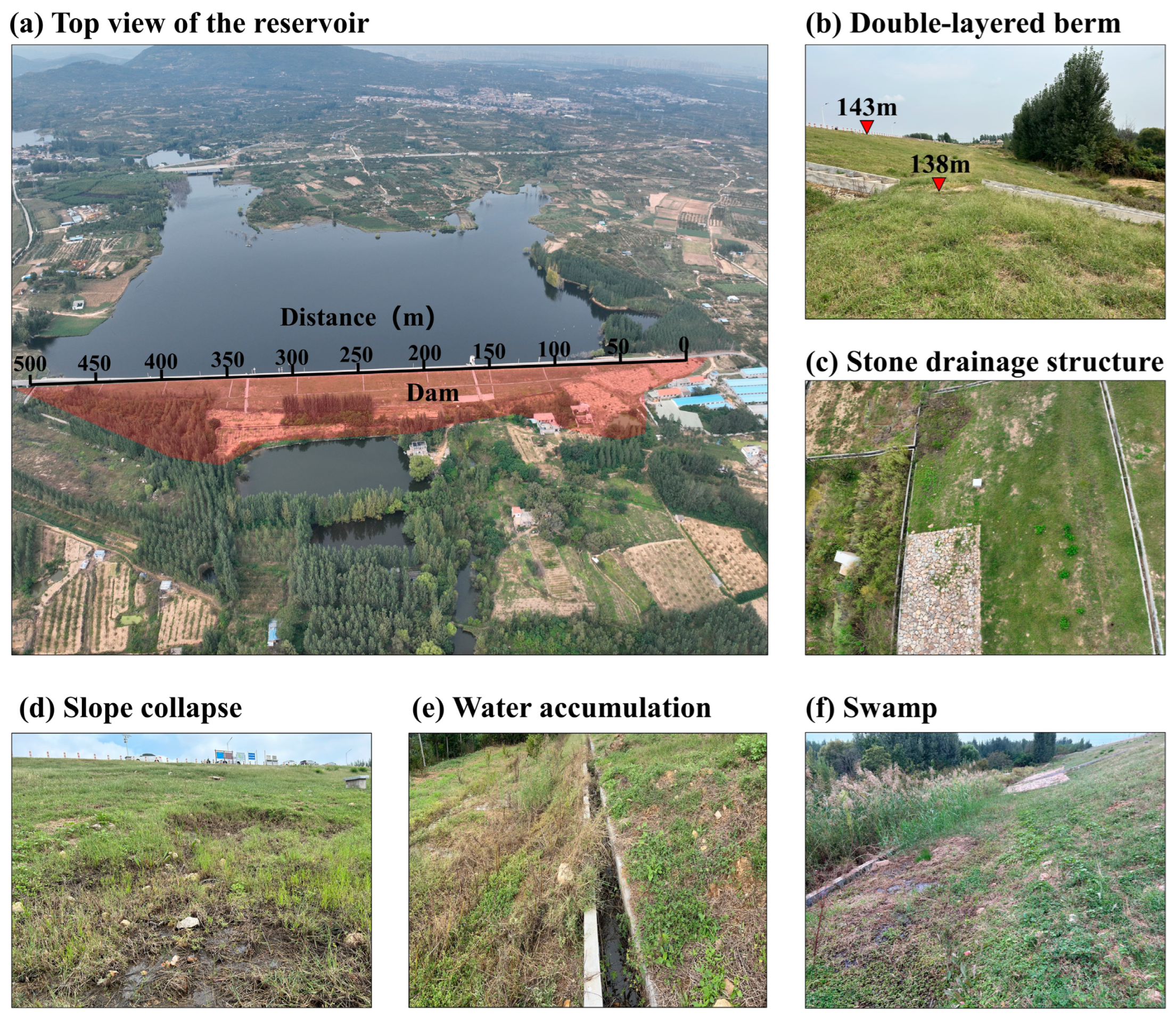

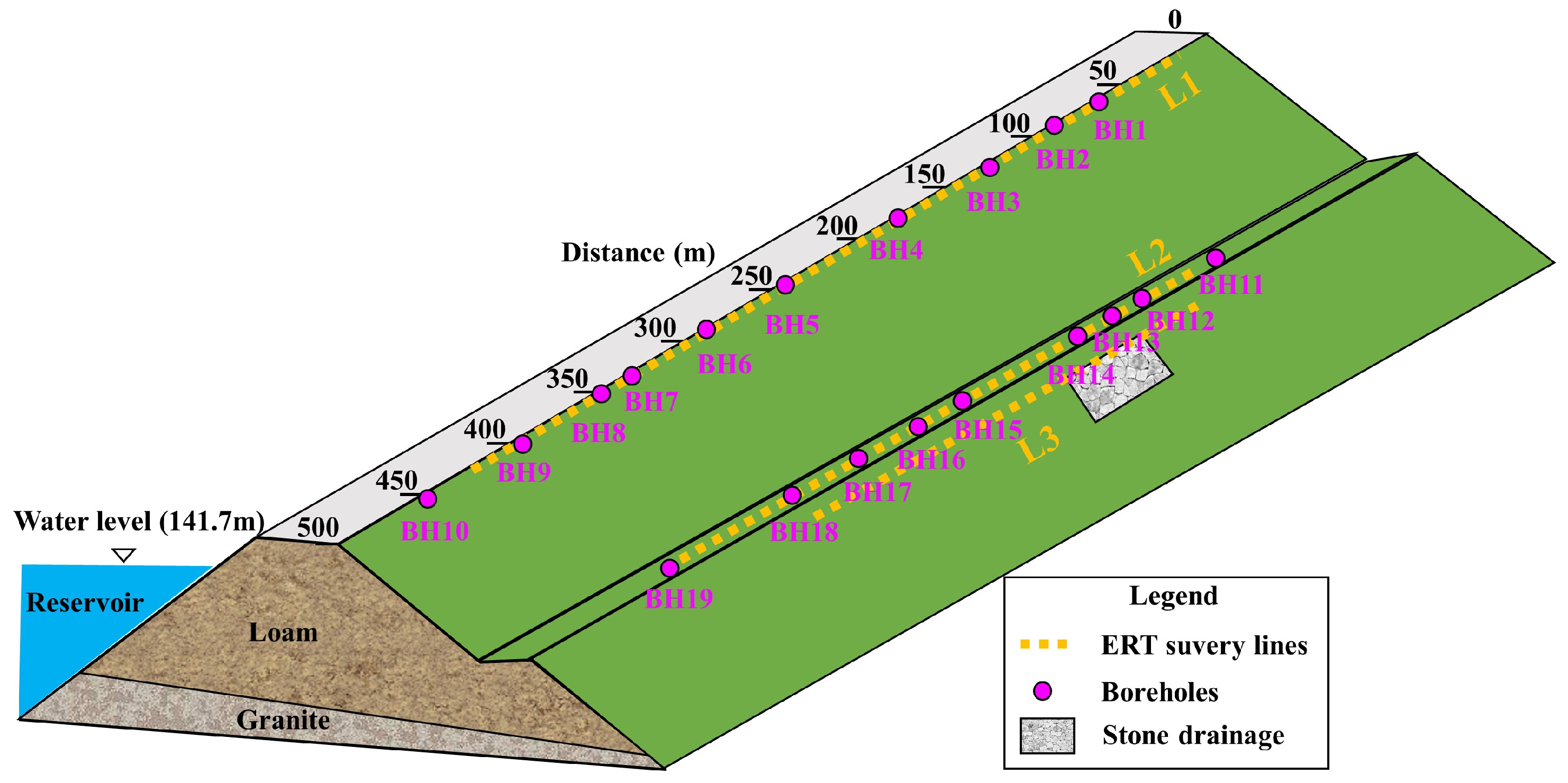

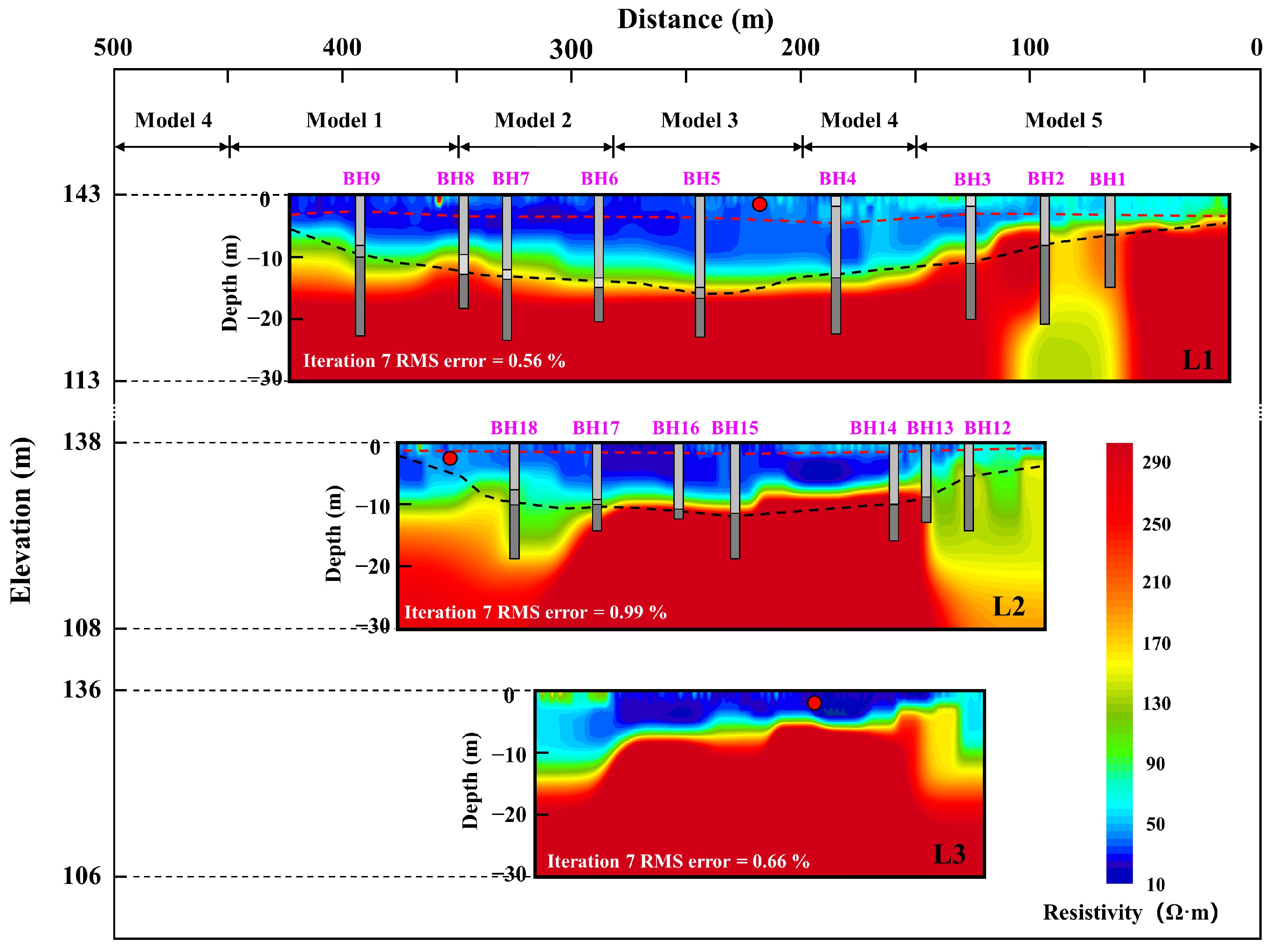
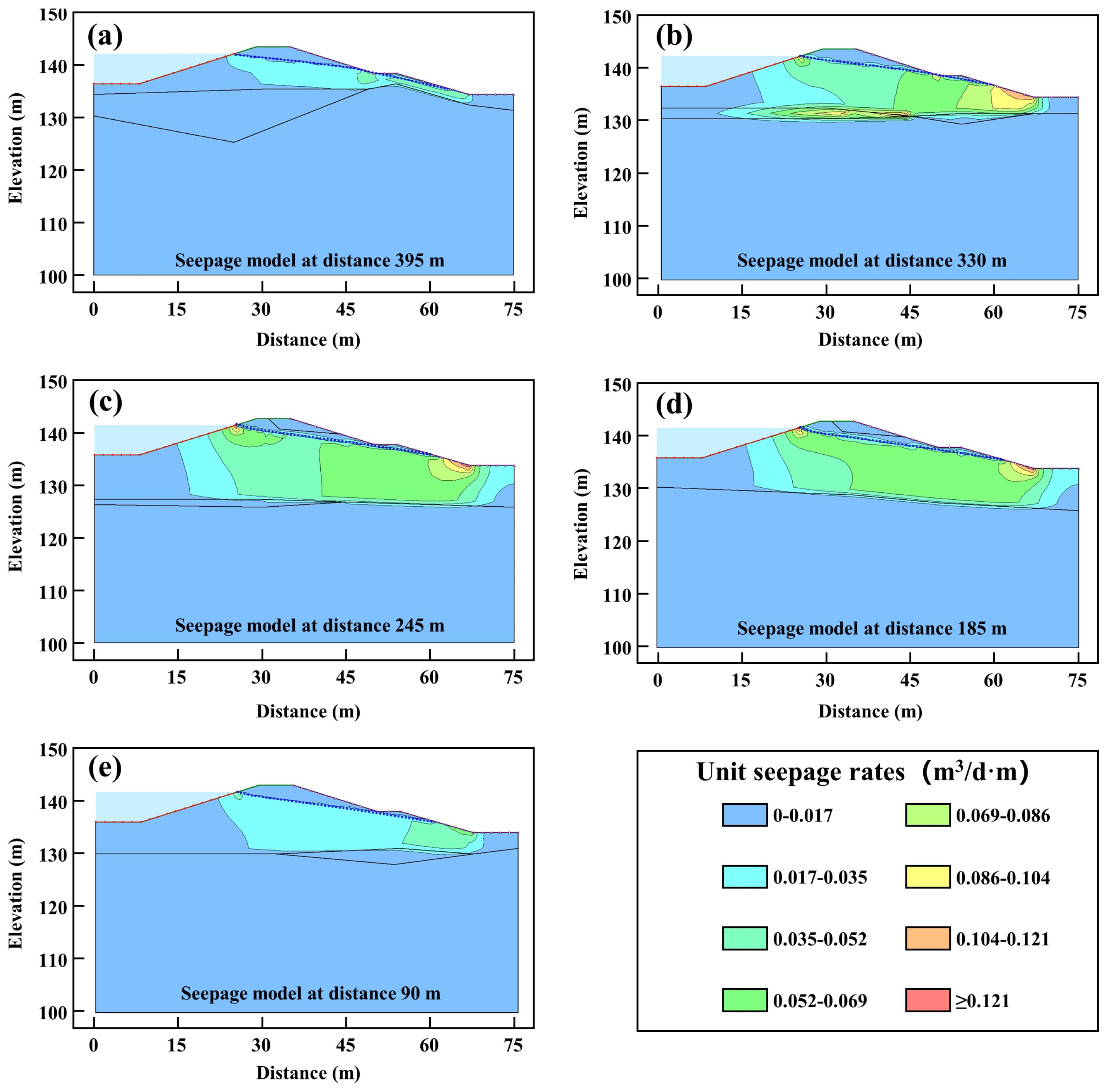
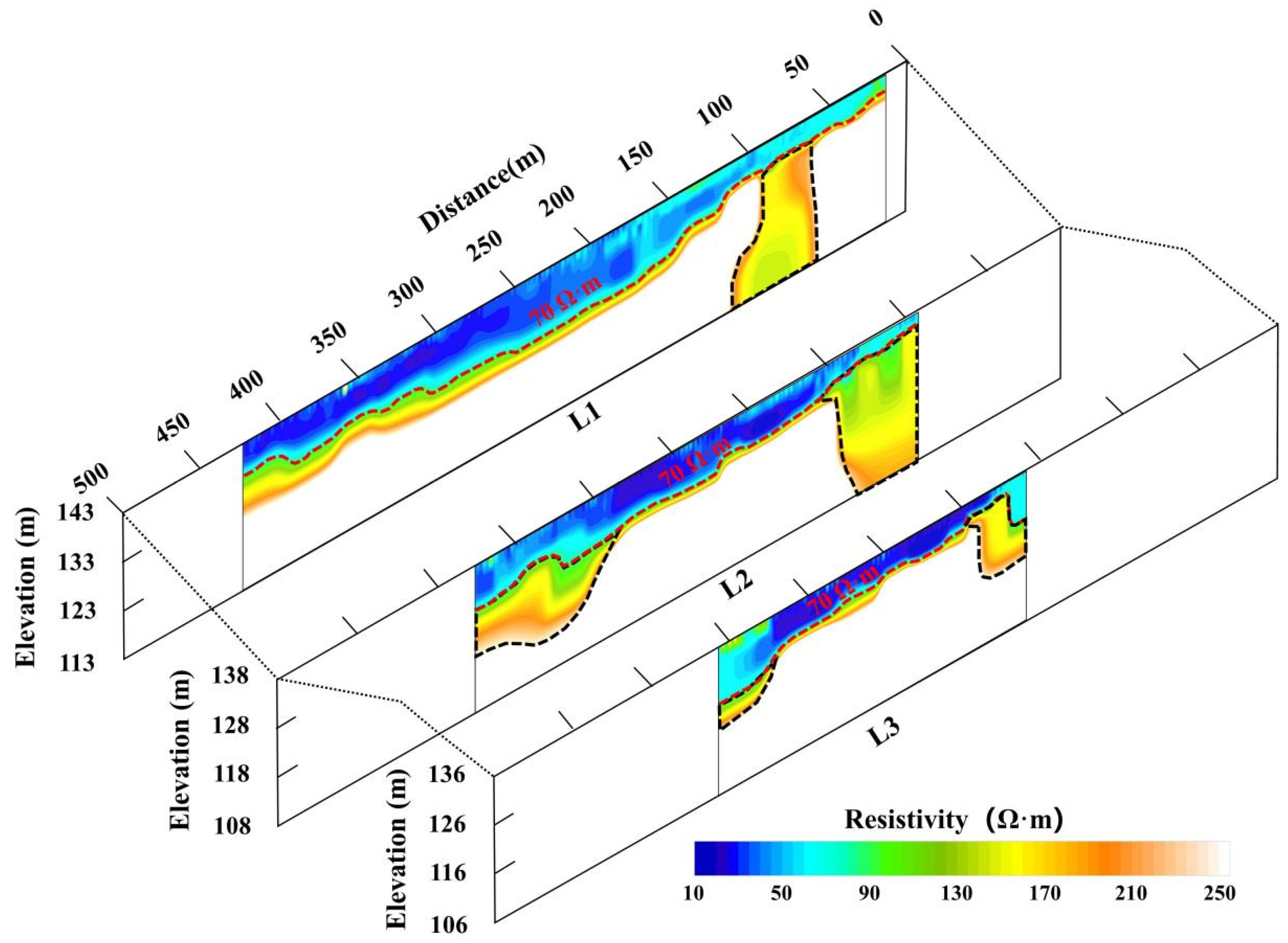
| Strata | Resistivity Values (Ω·m) | |
|---|---|---|
| Field Survey | Laboratory Measurements | |
| Sand | 70~250 | 263.2 |
| Loam | <70 | 28.9, 43.1 |
| Granite | >250 | - |
| Models | Unit Seepage Rates (m3/d.m) | Representative Area | Annual Seepage Volume of Representative Area (m3) | Pecentage in Total Seepage (%) |
|---|---|---|---|---|
| Model 1 | 0.168 | 350–450 m | 6132.00 | 7.77 |
| Model 2 | 0.572 | 280–350 m | 14,614.60 | 18.53 |
| Model 3 | 0.759 | 200–280 m | 22,162.80 | 28.10 |
| Model 4 | 0.624 | 150–200 m, 450–500 m | 22,776.00 | 28.87 |
| Model 5 | 0.241 | 0–150 m | 13,194.75 | 16.73 |
| The total annual seepage of the dam | 78,880.15 | - | ||
Disclaimer/Publisher’s Note: The statements, opinions and data contained in all publications are solely those of the individual author(s) and contributor(s) and not of MDPI and/or the editor(s). MDPI and/or the editor(s) disclaim responsibility for any injury to people or property resulting from any ideas, methods, instructions or products referred to in the content. |
© 2024 by the authors. Licensee MDPI, Basel, Switzerland. This article is an open access article distributed under the terms and conditions of the Creative Commons Attribution (CC BY) license (https://creativecommons.org/licenses/by/4.0/).
Share and Cite
Jian, J.; Lu, J.; Guo, Q.; Wang, J.; Sun, L.; Mao, D.; Wang, Y. Characterization and Quantification of Dam Seepage Based on Resistivity and Geological Information. Water 2024, 16, 2410. https://doi.org/10.3390/w16172410
Jian J, Lu J, Guo Q, Wang J, Sun L, Mao D, Wang Y. Characterization and Quantification of Dam Seepage Based on Resistivity and Geological Information. Water. 2024; 16(17):2410. https://doi.org/10.3390/w16172410
Chicago/Turabian StyleJian, Jianbo, Jinge Lu, Qifeng Guo, Junzhi Wang, Lu Sun, Deqiang Mao, and Yaxun Wang. 2024. "Characterization and Quantification of Dam Seepage Based on Resistivity and Geological Information" Water 16, no. 17: 2410. https://doi.org/10.3390/w16172410
APA StyleJian, J., Lu, J., Guo, Q., Wang, J., Sun, L., Mao, D., & Wang, Y. (2024). Characterization and Quantification of Dam Seepage Based on Resistivity and Geological Information. Water, 16(17), 2410. https://doi.org/10.3390/w16172410






